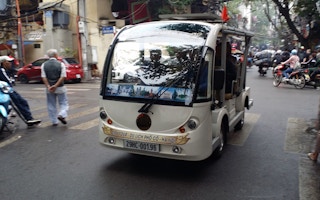The Covid-19 crisis has caused a global economic slowdown, wiped value off stock markets and led to job layoffs.
With mobility restrictions urgently imposed to limit the transmission of the coronavirus, events cancelled, consumers’ spending power affected and the public having to adopt new routines and behaviour amid the pandemic, the automotive and transportation industry is facing tough times.
According to the International Energy Agency (IEA), global passenger vehicle sales were down by 15 per cent in the first quarter of 2020.
On the supply side, industrial closure and supply chain disruption affected production lines. Post-pandemic, vehicle manufacturers are looking at a long recovery period.
The continuation of Covid-19 mitigating measures—social distancing, lockdowns, quarantines and temporary closure of non-essential businesses—could shackle energy demand, keeping the oil prices low. This will hinder the energy transition, including the adoption of electric vehicles (EVs).
However, the crisis will also bring about opportunities. The cleaner air that urban dwellers experienced due to mobility restrictions could encourage more people to switch swiftly to clean technologies, including EVs.
EV sales are expected to be more resilient than conventional vehicles in the long run. Bloomberg New Energy Finance (BNEF) has forecasted that post-lockdowns, EVs will make up 58 per cent of new passenger car sales, and constitute 31 per cent of the global car fleet by 2040.
In driving economic recovery, governments, including in Southeast Asia, should design clean mobility pathways. Among other benefits, green mobility will help prevent a spike in air pollution levels—and a return to smog-filled days in cities like Jakarta, Manila and Bangkok—once energy demand picks up.
Positive signs in the EV market can be observed. The market share of EVs in Norway reached 66 per cent in June, up from 62 per cent last June. While overall car sales in Norway dropped by 25.5 per cent year on year, EV sales dropped by 14.4 per cent only.
Meanwhile, China will continue its subsidy to the EV industry until 2022 and the United Kingdom plans to provide a direct incentive to consumers who want to switch to EVs.
To promote EVs, some countries with significant automotive industries tend to channel incentives to the supply side, while others attempt to entice consumers to purchase private electric cars. How about the Association of Southeast Asian Nations (Asean)?
As a region, Southeast Asia is the fifth-largest automotive market in the world. In 2019, regional sales reached 3.4 million units, a slight decline from the 3.5 million units sold in 2018. The proportion of EVs, though, is still insignificant. Surveys by Nissan found that the top barriers to EV uptake in the region are the fear of “running out of power”, “safety concerns”, and “limited public and private infrastructure”.
Electrify public and commercial transportation
In light of such barriers, the game-changer in the near term would be the electrification of public and commercial transportation. Just before the pandemic, the region showed great promise in this area.
In Thailand, the government teamed up with the automotive industry to electrify the iconic tuk-tuk. In Singapore, ride-hailing company Grab rolled out 200 EVs in the country. In Indonesia, it offered a similar service for airport transfers. An Indonesian taxi company, Blue Bird, also operates e-taxis with potential expansion of its fleet.
Such a strategy could reduce the need to develop a wide range of EV models. Public and commercial vehicles have a high utilisation rate and, with proper incentives from the government, the impact of such EVs can be increased drastically. Further, charging stations can be strategically placed to reduce the investment needed for the infrastructure.
Address demand for two-wheelers
Private vehicles could also gain favour post-Covid-19, as more commuters avoid mass transport whenever possible.
The industry could make use of this opportunity to push out EV models that are affordable yet reliable in the municipal areas with distinct mobility characteristics. The post-Covid-19 EVs could also be equipped with safety measures such as air purifiers.
Besides light duty vehicles, EV expansion in the region should also consider two-wheelers. The region represents 22.4 per cent of the global motorcycle market. In 2019, around 13.75 million units of motorcycles and scooters were sold. This represents a huge potential market to be tapped.
Support homegrown companies
As for EV makers, we believe they will be able to reboot and restart their manufacturing processes more swiftly as EVs have fewer parts than internal combustion engine vehicles. Even during the pandemic, factories such as Tesla’s in Thailand managed to keep running.
We are also encouraged by Asean’s homegrown EV manufacturers. Vietnam’s VinFast, which is set to launch its first electric car next year, is currently expanding its presence overseas. Similarly in Singapore, EV start-ups Scorpio Electric and Ion Mobility are raring to launch their products post-Covid-19, and the country has set an ambitious target to phase out internal combustion engine vehicles within two decades.
Thailand’s Board of Investment recently approved 24 projects by carmakers to produce EVs of all types with a combined capacity of over 500,000 units per year. In Malaysia, the National Automotive Policy (NAP2020) issued in February 2020 targets the development of technologies for next-generation vehicles.
Synergise green recovery, renewable energy and battery strategies
Governments should, therefore, incorporate measures to boost adoption of EVs in their stimulus packages and policies for economic recovery. Jakarta, for example, could continue with its plan to purchase electric buses for its Trans Jakarta line.
While some argue that the positive impact of EVs is diminished if their electricity source remains fossil fuel-based, a recent study reported that EVs produce lower net emissions compared to internal combustion engine vehicles in most of world’s regions. Moreover, EVs will undoubtedly become cleaner in the coming years as a global transition to renewable energy gathers pace, including in Asean.
As of 2017, the region employed 62 gigawatts of renewables, mainly hydropower. With an aspirational target of 23 per cent renewable energy share in the total primary energy supply, countries in the region have been advancing their renewable energy policies, such as auction schemes (Malaysia, Myanmar) and feed-in tariffs (Vietnam).
Indonesia, which has large deposits of key raw minerals, also plans to build EV battery plants by 2023. This is to support the development of EVs regulated by Ministry Regulation of Transportation No. 45/2020.
The price of lithium-ion batteries is predicted to fall further, and some studies have shown that, in certain environments, the levelised cost of driving EVs can be comparable to fossil fuel vehicles.
Despite promising future projections, the uptake of EV depends heavily on strategic decisions and actions of its key stakeholders—industry, government, and consumers. With the right post-pandemic green recovery measures in place, we may very well see an EV revolution in Asean.
Dr Zulfikar Yurnaidi is senior officer of sustainable energy, renewable energy, and energy efficiency (REE) at the Asean Centre for Energy. He holds a doctoral degree in Energy Studies from the Ajou University in the Republic of Korea.
Justin Sitohang is an intern at the Asean Centre for Energy. He holds a Bachelor of Science degree in electrical power engineering from Institut Teknologi Bandung, Indonesia.










